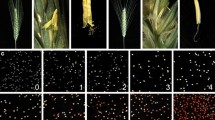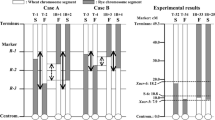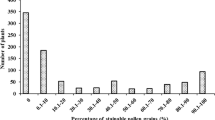Abstract
Partial restoration of male fertility limits the use of C-type cytoplasmic male sterility (C-CMS) for the production of hybrid seeds in maize. Nevertheless, the genetic basis of the trait is still unknown. Therefore, the aim to this study was to identify genomic regions that govern partial restoration by means of a QTL analysis carried out in an F2 population (n = 180). This population was derived from the Corn Belt inbred lines B37C and K55. F2BC1 progenies were phenotyped at three locations in Switzerland. Male fertility was rated according to the quality and number of anthers as well as the anthesis-silking interval. A weak effect of environment on the expression of partial restoration was reflected by high heritabilities of all fertility-related traits. Partial restoration was inherited like an oligogenic trait. Three major QTL regions were found consistently across environments in the chromosomal bins 2.09, 3.06 and 7.03. Therefore, a marker-assisted counter-selection of partial restoration is promising. Minor QTL regions were found on chromosomes 3, 4, 5, 6 and 8. A combination of partial restorer alleles at different QTL can lead to full restoration of fertility. The maternal parent was clearly involved in the partial restoration, because the restorer alleles at QTL in bins 2.09, 6.04 and 7.03 originated from B37. The three major QTL regions collocated with other restorer genes of maize, a phenomenon, which seems to be typical for restorer genes. Therefore, a study of the clusters of restorer genes in maize could lead to a better understanding of their evolution and function. In this respect, the long arm of chromosome 2 is particularly interesting, because it harbors restorer genes for the three major CMS systems (C, T and S) of maize.




Similar content being viewed by others
References
Bentolila S, Alfonso AA, Hanson MR (2002) A pentatricopeptide repeat-containing gene restores fertility to cytoplasmic male-sterile plants. Proc Natl Acad Sci USA 99:10887–10892
Butler DG, Cullis BR, Gilmour AR, Gogel BJ (2007) Analysis of mixed models for S language environments. ASReml-R reference manual. Release 2 (2007). Queensland Department of Primary Industries and Fisheries, GPO Box 46, Brisbane, QLD, 4001, Australia
Churchill GA, Doerge RW (1996) Empirical threshold values for quantitative trait mapping. Genetics 138:963–971
Desloire S, Gherbi H, Laloui W, Marhadour S, Clouet V, Cattolico L, Falentin C, Giancola S, Renard M, Budar F, Small I, Caboche M, Delourme R, Bendahmane A (2003) Identification of the fertility restoration locus, Rfo, in radish, as a member of the pentatricopeptide-repeat protein family. EMBO Rep 4:588–594
Dill CL, Wise RP, Schnable PS (1997) Rf8 and Rf* mediate unique T-urf13-transcript accumulation, revealing a conserved motif associated with RNA processing and restoration of pollen fertility in T-cytoplasm maize. Genetics 147:1367–1379
Duvick DN (1956) Allelism and comparative genetics of fertility restoration of cytoplasmically pollen sterile maize. Genetics 41:544–565
Duvick DN (1965) Cytoplasmic pollen sterility in corn. Adv Genet 13:2–52
Fan J, Oliphant A, Shen R, Kermani B, Garcia F, Gunderson K, Hansen M, Steemers F, Butler S, Deloukas P, Galver L, Hunt S, McBride C, Bibikova M, Rubano T, Chen J, Wickham E, Doucet D, Chang W, Campbell D, Zhang B, Krugylak S, Bentley D, Haas J, Rigault P, Zhou L, Stuelpnagel J, Chee M (2003) Highly parallel SNP genotyping. Cold Spring Harb Symp Quant Biol 68:6978
Gabay-Laughnan S, Chase CD, Ortega VM, Zhao LM (2004) Molecular-genetic characterization of CMS-S restorer-of-fertility alleles identified in Mexican maize and teosinte. Genetics 166:959–970
Gaut BS (2001) Patterns of chromosomal duplication in maize and their implications for comparative maps of the grasses. Genome Res 11:55–66
Gontarovskii V (1974) Role of supplementary genes in control of Texas type of CMS in maize. Genetika 10:15–24
Has V (2002) Evaluation of some maize inbred lines on fertility restoration patterns of male-sterile cytoplasms. Romanian Agric Res 17:1–7
Hospital F, Moreau L, Lacoudre F, Charcosset A, Gallais A (1997) More on the efficiency of marker-assisted selection. Theor Appl Genet 95:1181–1189
Hu Y, Tang J, Yang H, Xie H, Lu X, Niu J, Chen W (2006) Identification and mapping of Rf-I an inhibitor of the Rf5 restorer gene for Cms-C in maize (Zea mays L.). Theor Appl Genet 113:357–360
IUSS Working Group WRB (2007) World Reference Base for Soil Resources 2006, first update 2007. World Soil Resources Reports No. 103. FAO, Rome
Jones DF, Manglesdorf PC (1951) The production of hybrid corn seed without detasseling. Conn Agric Exper Sta Bull 550
Kaul M (1988) Male sterility in higher plants. Springer, Berlin
Kheyr-Pour A, Gracen VE, Everett HL (1981) Genetics of fertility restoration in the C-group of cytoplasmic male-sterility in maize. Genetics 98:379–388
Kosambi DD (1944) The estimation of map distances from recombination values. Ann Eugenics 12:172–175
Li HH, Ye GY, Wang JK (2007) A modified algorithm for the improvement of composite interval mapping. Genetics 175:361–374
Li XQ, Jean M, Landry BS, Brown GG (1998) Restorer genes for different forms of Brassica cytoplasmic male sterility map to a single nuclear locus that modifies transcripts of several mitochondrial genes. Proc Natl Acad Sci USA 95:10032–10037
Munsch A, Stamp P, Christov NK, Foueillassar XM, Hüsken A, Camp KH, Weider C (2009) Grain yield increase and pollen containment by Plus-Hybrids could improve acceptance of transgenic maize. Crop Sci 50:909–919
Osbourn A (2010) Secondary metabolic gene clusters: evolutionary toolkits for chemical innovation. Trends Genet 26:449–457
Qin T, Xu M, Dun D (1990) Cytoplasmic male sterility: identification of the number of the restorer genes. MNL 64:124
R Development Core Team (2009) A language and environment for statistical computing. R foundation for statistical computing, Vienna, Austria. http://www.R-project.org. Accessed 10 November 2010
Schaeffer (Polacco) M, Sanchez-Villeda H, Coe E (2008) IBM neighbors 2008 map. Available at http://www.maizegdb.org. Maize Genetics and Genomics Database. Accessed 10 November 2010
Sisco PH (1991) Duplications complicate genetic mapping of Rf4, a restorer for CMS-C cytoplasmic male sterility in corn. Crop Sci 31:1263–1266
Soller M, Beckmann JS (1990) Marker-based mapping of quantitative trait loci using replicated progenies. Theor Appl Genet 80:205–208
Sotchenko V, Gorbacheva A, Kosogorova N (2007) C-type cytoplasmic male sterility in corn. Russian Agric Sci 33:83–86
Touzet P, Budar F (2004) Unveiling the molecular arms race between two conflicting genomes in cytoplasmic male sterility?. Trends Plant Sci 9:568–570
Tracy WF, Everett HL, Gracen VE (1991) Inheritance, environmental effects, and partial male-fertility in C-type CMS in a maize inbred. J Hered 82:343–346
Utz H, Melchinger A (2000) PLABQTL: a computer program for statistical analysis of plant breeding experiments. Release version 1.1
Van Ooijen J (2006) JoinMap4, Software for the calculation of genetic linkage maps in experimental populations. Kyazma B.V., Wageningen, The Netherlands
Vidakovic M (1988) Genetics of fertility restoration in cytoplasmic male-sterility of the c-type (cmsC) in maize (Zea mays L.). Maydica 33:51–64
Wang Z, Zou Y, Li X, Zhang Q, Chen L, Wu H, Su D, Chen Y, Guo J, Luo D, Long Y, Zhong Y, Liu Y (2006) Cytoplasmic male sterility of rice with Boro II cytoplasm is caused by a cytotoxic peptide and is restored by two related PPR motif genes via distinct modes of mRNA silencing. Plant Cell 18:676–687
Wang ZW, Zhang YJ, Xiang CP, Mei SY, Zhou Y, Chen GP, Wang T (2008) A new fertility restorer locus linked closely to the Rfo locus for cytoplasmic male sterility in radish. Theor Appl Genet 117:313–320
Weider C, Stamp P, Christov N, Hüsken A, Foueillassar X, Camp KH, Munsch M (2009) Stability of cytoplasmic male sterility in maize under different environmental conditions. Crop Sci 49:77–84
Zeng ZB (1994) Precision mapping of quantitative trait loci. Genetics 136:1457–1468
Zhang JF, Stewart JM (2001) Inheritance and genetic relationships of the D8 and D2-2 restorer genes for cotton cytoplasmic male sterility. Crop Sci 41:289–294
Zhu S, Rossnagel BG, Kaeppler HF (2004) Genetic analysis of quantitative trait loci for groat protein and oil content in oat. Crop Sci 44:254–260
Acknowledgments
We are grateful to Karl-Heinz Camp and Delley Seeds and Plants Ltd (Delley, Switzerland), Mario Bertossa and Agroscope Changins-Wädenswil in Cadenazzo (Switzerland) and Ernst Weiss for their support of the field trials. Agroscope Reckenholz-Tänikon (Zurich, Switzerland) provided access to JoinMap 4.0. We further thank Marianne Wettstein for her excellent technical assistance and Angela Steinauer, Adrian Ramseyer and Marylène Maillard for their assistance in the collection of data.
Author information
Authors and Affiliations
Corresponding author
Additional information
Communicated by R. Johnson.
Rights and permissions
About this article
Cite this article
Kohls, S., Stamp, P., Knaak, C. et al. QTL involved in the partial restoration of male fertility of C-type cytoplasmic male sterility in maize. Theor Appl Genet 123, 327–338 (2011). https://doi.org/10.1007/s00122-011-1586-8
Received:
Accepted:
Published:
Issue Date:
DOI: https://doi.org/10.1007/s00122-011-1586-8




